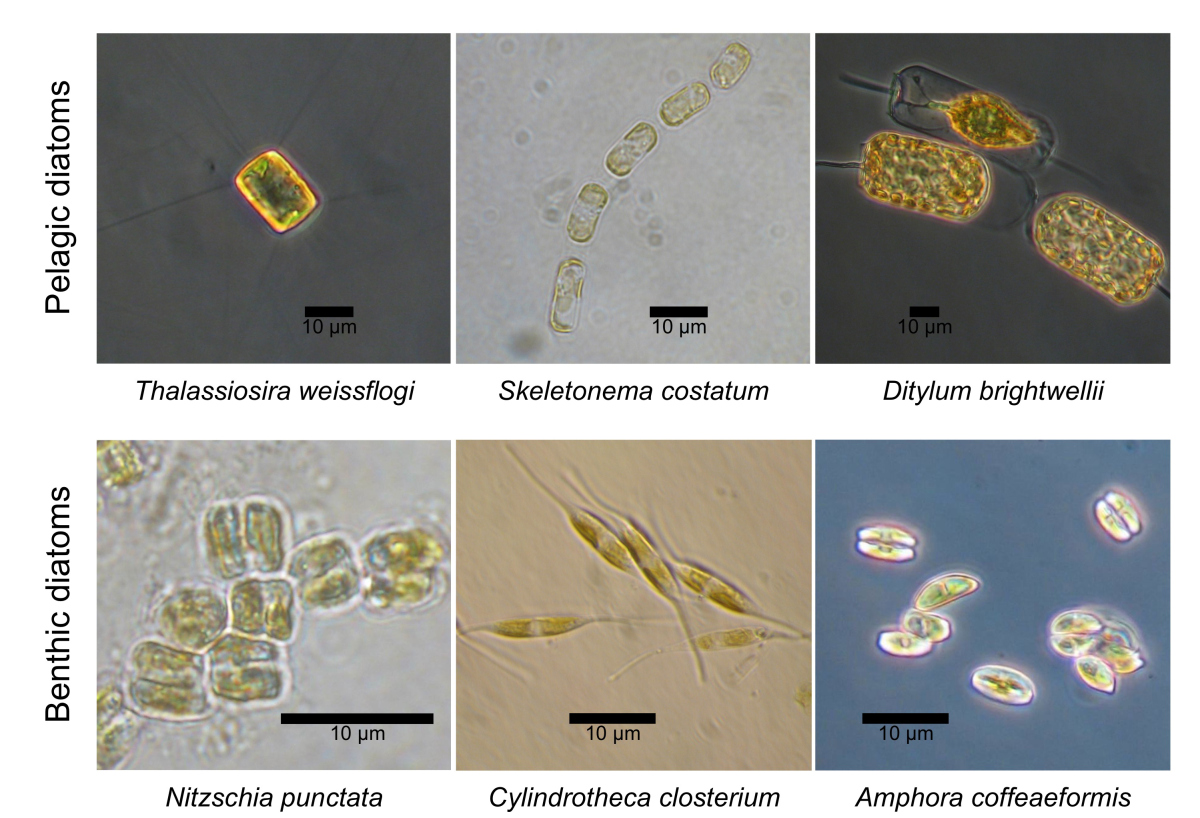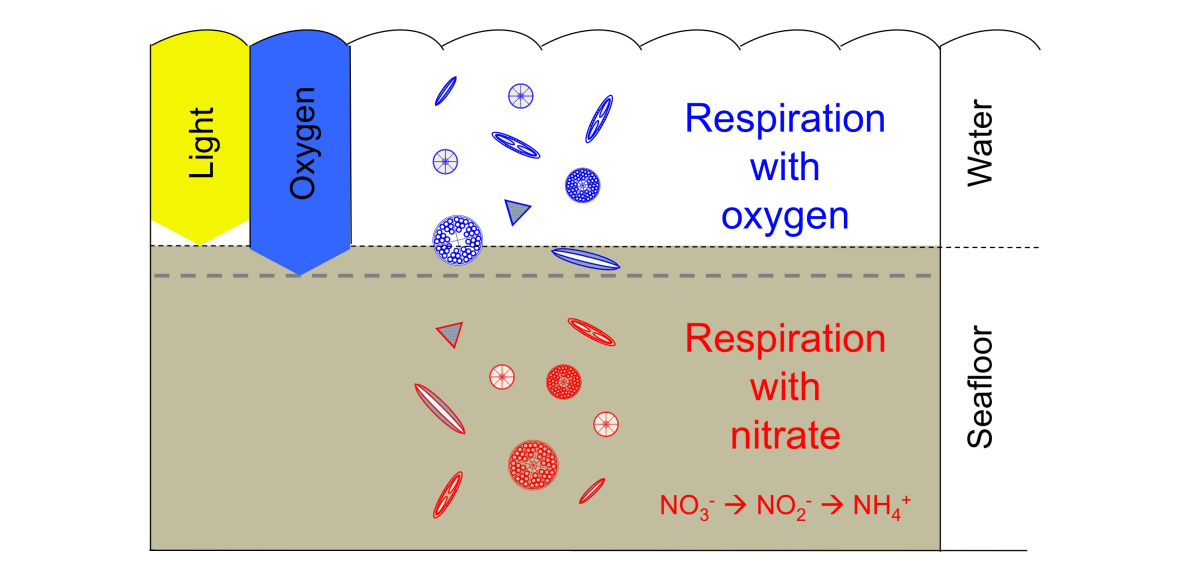Page path:
- Press Office
- Highlights 2000 - 2011
- 14.03.2011 Algae in darkness – Survival strat...
14.03.2011 Algae in darkness – Survival strategy unraveled
Algae in darkness – Survival strategy unraveled
Microalgae often measure only a few hundredths of a millimeter, but due to their vast abundance in the world’s oceans they are responsible for approximately 40% of the marine primary production, i.e., the biomass production via carbon dioxide fixation in the sunlight. They often appear as massive blooms near the sea surface or on the seafloor as greenish-brownish meadows in shallow waters if the sunlight still reaches them. However, some microalgae, specifically diatoms (unicellular algae with a silicate frustule), are also able to survive in the absence of sunlight and oxygen, for instance, buried in the sea floor.
Anja Kamp, Dirk de Beer, Jana L. Nitsch, Gaute Lavik, and Peter Stief, scientists at the Max Planck Institute for Marine Microbiology in Bremen cultivated several diatom species in the laboratory to explore the metabolic process that allows the tiny algae to survive in darkness. A correlation was found between the nitrate that is stored by a diatom and its ability to survive in the absence of sunlight and oxygen. The more nitrate the diatom contained, the longer it could survive in darkness where it does not have the possibility to produce oxygen via photosynthesis for its own respiration. In experiments with the coffee-bean-shaped diatom Amphora coffeaeformis, the scientists proved that diatoms use the nitrate stored in their cells for respiration in the absence of oxygen. Within just one day, most of the stored nitrate is used up, converted to ammonium, and excreted by the cell.
Figure 1: Diatoms living in the water column (pelagic diatoms) and living on the sea bottom (benthic), which have been investigated in the study of Anja Kamp and colleagues. Photos: Anja Kamp
A key finding of the Max-Planck scientists was that diatoms use nitrate just for respiration rather than for biomass production, as would be the case in sunlight. "The rapid consumption of nitrate and the absence of biomass production tell us that nitrate respiration in diatoms is a metabolic process that only serves to prepare the cell for a resting stage and therefore nitrate respiration is not sustained for longer time periods," says lead author Anja Kamp.
Nitrate respiration in the absence of oxygen is nothing new to the researchers at the Max Planck Institute for Microbiolgoy, as many of the bacteria studied at the institute are able to breathe with nitrate, sulfate, or even iron compounds. What is spectacular is the discovery that algae, i.e., organisms with a cell nucleus, are able carry out both photosynthesis and nitrate respiration, each under different environmental conditions. These results have just been published in the renowned interdisciplinary journal Proceedings of the National Academy of Sciences.
Nitrate respiration in the absence of oxygen is nothing new to the researchers at the Max Planck Institute for Microbiolgoy, as many of the bacteria studied at the institute are able to breathe with nitrate, sulfate, or even iron compounds. What is spectacular is the discovery that algae, i.e., organisms with a cell nucleus, are able carry out both photosynthesis and nitrate respiration, each under different environmental conditions. These results have just been published in the renowned interdisciplinary journal Proceedings of the National Academy of Sciences.
Figure 2: Diatoms (unicellular algae with a silicate frustule) obtain their energy in sunlight through photosynthesis. This process also produces oxygen, which penetrates deeper into the seabed than light. Diatoms use part of this oxygen for their cellular respiration, exactly like animals and humans "breathe" with oxygen. However, diatoms can survive buried in the seabed, where neither light nor oxygen is available. Here, they respire with nitrate instead of oxygen. For prokaryotes (i.e., organisms without a nucleus such as bacteria), several metabolic pathways of nitrate respiration are described. Eukaryotes (i.e., organisms with a nucleus, such as diatoms) that are able to carry out both photosynthesis and nitrate respiration, however, have previously not been known. The pathway of nitrate respiration discovered in diatoms is Dissimilatory Nitrate Reduction to Ammonium (DNRA). Here, nitrate (NO<sub>3</sub><sup>-</sup>) is first reduced to nitrite (NO<sub>2</sub><sup>-</sup>) and then to ammonium (NH<sub>4</sub><sup>+</sup>). Scheme: Anja Kamp
Further inquiries to:
Dr. Anja Kamp; Phone: +49 421 2028 856; [Bitte aktivieren Sie Javascript]
or to the press officer:
Dr. Manfred Schlösser; Phone: +49 421 2028 704; [Bitte aktivieren Sie Javascript]
Original article (Download):
Kamp, A., de Beer, D., Nitsch, J.L., Lavik, G., and Stief, P. (2011) Diatoms respire nitrate to survive dark and anoxic conditions. Proceedings of the National Academy of Sciences of the USA, 108 (14): 5649-5654.
Mentioned as "in this issue" article
Dr. Anja Kamp; Phone: +49 421 2028 856; [Bitte aktivieren Sie Javascript]
or to the press officer:
Dr. Manfred Schlösser; Phone: +49 421 2028 704; [Bitte aktivieren Sie Javascript]
Original article (Download):
Kamp, A., de Beer, D., Nitsch, J.L., Lavik, G., and Stief, P. (2011) Diatoms respire nitrate to survive dark and anoxic conditions. Proceedings of the National Academy of Sciences of the USA, 108 (14): 5649-5654.
Mentioned as "in this issue" article
Figure 3: Laser-scanning-fluorescence image of the marine diatom Amphora coffeaeformis. Red: auto-fluorescing chloroplasts, green: lipid membranes (stained with MDY-64). Foto: Martin Beutler, bionsys GmbH, Bremen, Germany (www.bionsys.de).



